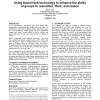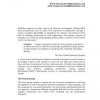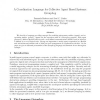7720 search results - page 5 / 1544 » A Model for Interface Groups |
SIGMOD
2009
ACM
14 years 7 months ago
2009
ACM
We are experiencing a new Social Web, where people share, communicate, commiserate, and conflict with each other. As evidenced by systems like Wikipedia, twitter, and delicious.co...
CHI
2009
ACM
14 years 8 months ago
2009
ACM
Conversation Clusters explores the use of visualization to highlight salient moments of live conversation while archiving a meeting. Cheaper storage and easy access to recording d...
EUROPLOP
2006
13 years 9 months ago
2006
The New Oxford Dictionary of English A powerful and well-chosen metaphor can speak a thousand words in terms of the insight it gives to the audience; a poor one can hide and confu...
CIKM
2009
Springer
14 years 8 days ago
2009
Springer
This paper describes a hidden Markov model (HMM) based approach to perform search interface segmentation. Automatic processing of an interface is a must to access the invisible co...
SAC
2000
ACM
14 years 3 hour ago
2000
ACM
We describe a language providing concepts for modeling autonomous entities (agents) and cooperating entities (groups). Agents are the execution units of a GroupLog program. Each a...



